check engine YAMAHA XVS1100A 2000 User Guide
[x] Cancel search | Manufacturer: YAMAHA, Model Year: 2000, Model line: XVS1100A, Model: YAMAHA XVS1100A 2000Pages: 104, PDF Size: 14.79 MB
Page 55 of 104
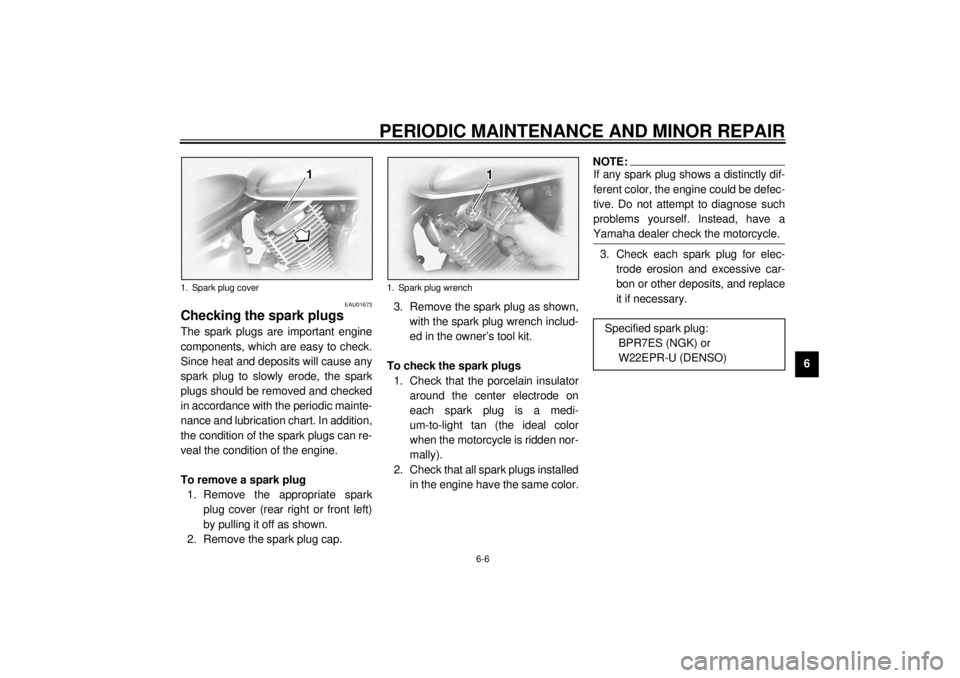
PERIODIC MAINTENANCE AND MINOR REPAIR
6-6
6
EAU01673
Checking the spark plugs The spark plugs are important engine
components, which are easy to check.
Since heat and deposits will cause any
spark plug to slowly erode, the spark
plugs should be removed and checked
in accordance with the periodic mainte-
nance and lubrication chart. In addition,
the condition of the spark plugs can re-
veal the condition of the engine.
To remove a spark plug
1. Remove the appropriate spark
plug cover (rear right or front left)
by pulling it off as shown.
2. Remove the spark plug cap.3. Remove the spark plug as shown,
with the spark plug wrench includ-
ed in the owner’s tool kit.
To check the spark plugs
1. Check that the porcelain insulator
around the center electrode on
each spark plug is a medi-
um-to-light tan (the ideal color
when the motorcycle is ridden nor-
mally).
2. Check that all spark plugs installed
in the engine have the same color.
NOTE:@ If any spark plug shows a distinctly dif-
ferent color, the engine could be defec-
tive. Do not attempt to diagnose such
problems yourself. Instead, have a
Yamaha dealer check the motorcycle. @3. Check each spark plug for elec-
trode erosion and excessive car-
bon or other deposits, and replace
it if necessary.
1. Spark plug cover
1. Spark plug wrench
Specified spark plug:
BPR7ES (NGK) or
W22EPR-U (DENSO)
E_5KS.book Page 6 Monday, August 21, 2000 10:48 AM
Page 56 of 104
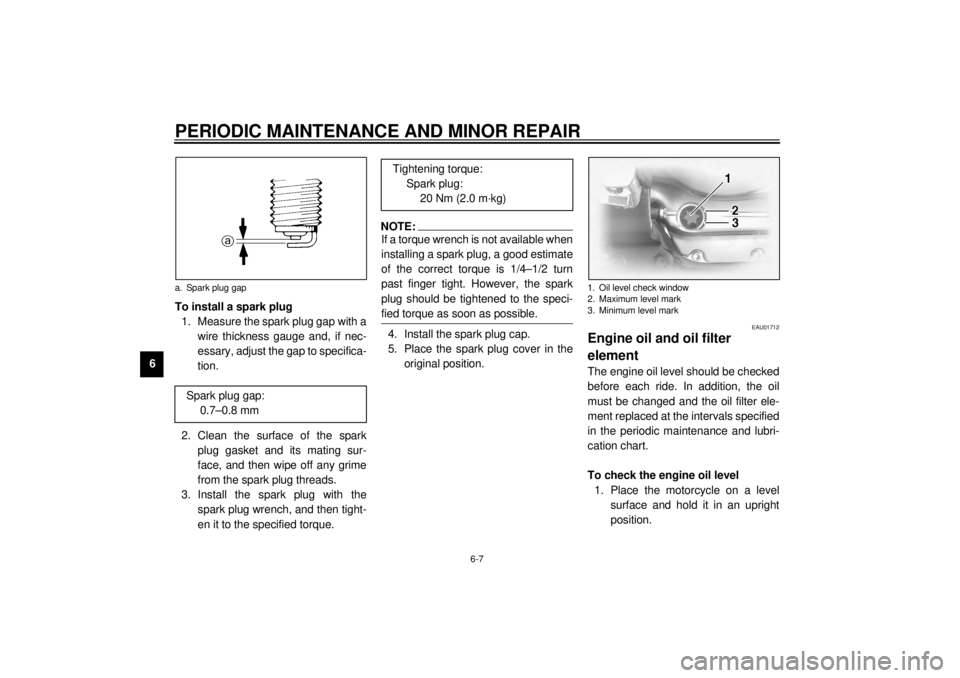
PERIODIC MAINTENANCE AND MINOR REPAIR
6-7
6To install a spark plug
1. Measure the spark plug gap with a
wire thickness gauge and, if nec-
essary, adjust the gap to specifica-
tion.
2. Clean the surface of the spark
plug gasket and its mating sur-
face, and then wipe off any grime
from the spark plug threads.
3. Install the spark plug with the
spark plug wrench, and then tight-
en it to the specified torque.
NOTE:@ If a torque wrench is not available when
installing a spark plug, a good estimate
of the correct torque is 1/4–1/2 turn
past finger tight. However, the spark
plug should be tightened to the speci-
fied torque as soon as possible. @4. Install the spark plug cap.
5. Place the spark plug cover in the
original position.
EAU01712
Engine oil and oil filter
element The engine oil level should be checked
before each ride. In addition, the oil
must be changed and the oil filter ele-
ment replaced at the intervals specified
in the periodic maintenance and lubri-
cation chart.
To check the engine oil level
1. Place the motorcycle on a level
surface and hold it in an upright
position.
a. Spark plug gapSpark plug gap:
0.7–0.8 mm
Tightening torque:
Spark plug:
20 Nm (2.0 m·kg)
1. Oil level check window
2. Maximum level mark
3. Minimum level mark
E_5KS.book Page 7 Monday, August 21, 2000 10:48 AM
Page 57 of 104
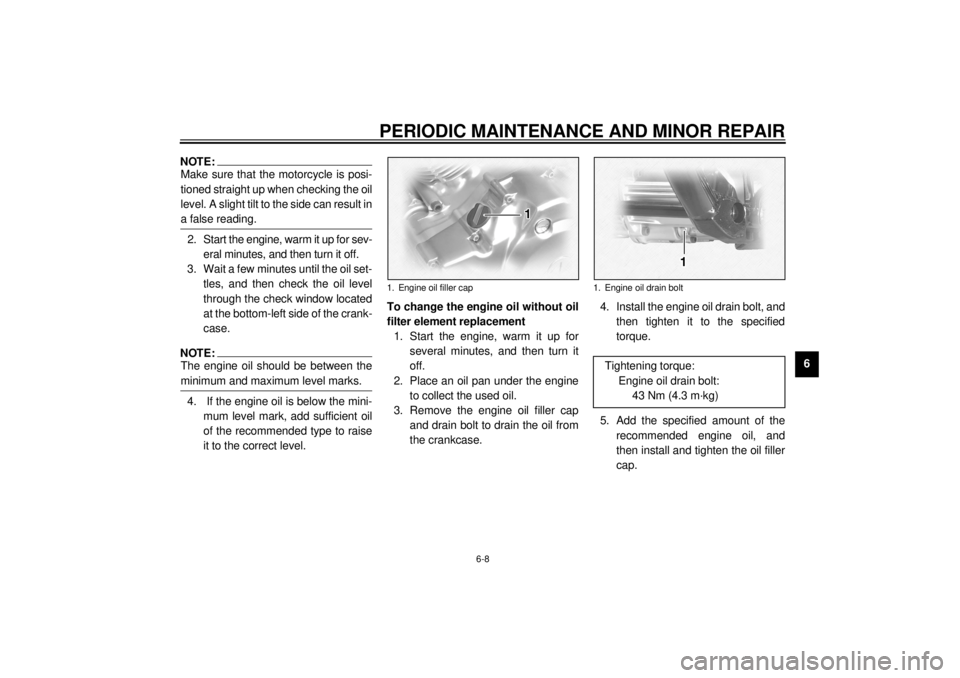
PERIODIC MAINTENANCE AND MINOR REPAIR
6-8
6
NOTE:Make sure that the motorcycle is posi-
tioned straight up when checking the oil
level. A slight tilt to the side can result in
a false reading. @2. Start the engine, warm it up for sev-
eral minutes, and then turn it off.
3. Wait a few minutes until the oil set-
tles, and then check the oil level
through the check window located
at the bottom-left side of the crank-
case.NOTE:@ The engine oil should be between the
minimum and maximum level marks.@4. If the engine oil is below the mini-
mum level mark, add sufficient oil
of the recommended type to raise
it to the correct level.To change the engine oil without oil
filter element replacement
1. Start the engine, warm it up for
several minutes, and then turn it
off.
2. Place an oil pan under the engine
to collect the used oil.
3. Remove the engine oil filler cap
and drain bolt to drain the oil from
the crankcase.4. Install the engine oil drain bolt, and
then tighten it to the specified
torque.
5. Add the specified amount of the
recommended engine oil, and
then install and tighten the oil filler
cap.
1. Engine oil filler cap
1. Engine oil drain boltTightening torque:
Engine oil drain bolt:
43 Nm (4.3 m·kg)
E_5KS.book Page 8 Monday, August 21, 2000 10:48 AM
Page 58 of 104
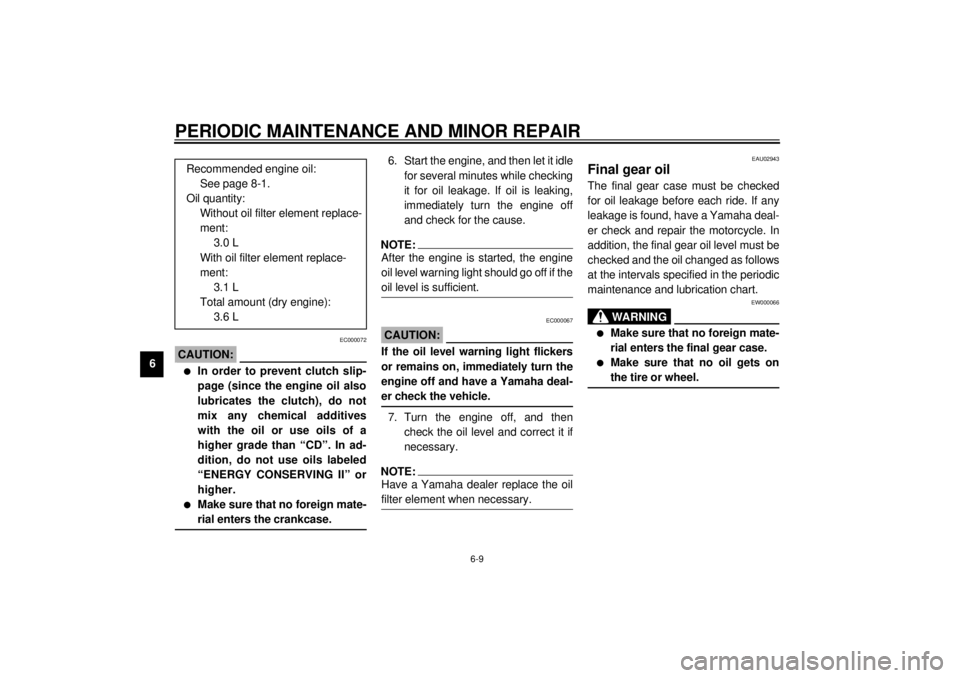
PERIODIC MAINTENANCE AND MINOR REPAIR
6-9
6
EC000072
CAUTION:@ l
In order to prevent clutch slip-
page (since the engine oil also
lubricates the clutch), do not
mix any chemical additives
with the oil or use oils of a
higher grade than “CD”. In ad-
dition, do not use oils labeled
“ENERGY CONSERVING II” or
higher.
l
Make sure that no foreign mate-
rial enters the crankcase.
@
6. Start the engine, and then let it idle
for several minutes while checking
it for oil leakage. If oil is leaking,
immediately turn the engine off
and check for the cause.NOTE:@ After the engine is started, the engine
oil level warning light should go off if the
oil level is sufficient. @
EC000067
CAUTION:@ If the oil level warning light flickers
or remains on, immediately turn the
engine off and have a Yamaha deal-
er check the vehicle. @7. Turn the engine off, and then
check the oil level and correct it if
necessary.NOTE:@ Have a Yamaha dealer replace the oil
filter element when necessary. @
EAU02943
Final gear oil The final gear case must be checked
for oil leakage before each ride. If any
leakage is found, have a Yamaha deal-
er check and repair the motorcycle. In
addition, the final gear oil level must be
checked and the oil changed as follows
at the intervals specified in the periodic
maintenance and lubrication chart.
EW000066
WARNING
@ l
Make sure that no foreign mate-
rial enters the final gear case.
l
Make sure that no oil gets on
the tire or wheel.
@
Recommended engine oil:
See page 8-1.
Oil quantity:
Without oil filter element replace-
ment:
3.0 L
With oil filter element replace-
ment:
3.1 L
Total amount (dry engine):
3.6 L
E_5KS.book Page 9 Monday, August 21, 2000 10:48 AM
Page 59 of 104
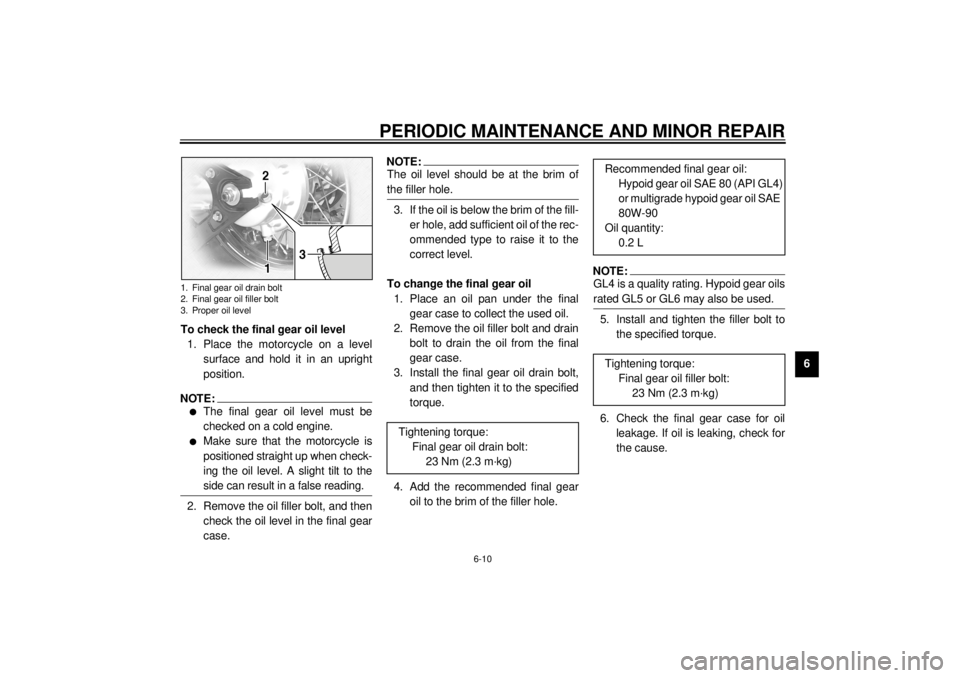
PERIODIC MAINTENANCE AND MINOR REPAIR
6-10
6 To check the final gear oil level
1. Place the motorcycle on a level
surface and hold it in an upright
position.
NOTE:@ l
The final gear oil level must be
checked on a cold engine.
l
Make sure that the motorcycle is
positioned straight up when check-
ing the oil level. A slight tilt to the
side can result in a false reading.
@2. Remove the oil filler bolt, and then
check the oil level in the final gear
case.
NOTE:@ The oil level should be at the brim of
the filler hole. @3. If the oil is below the brim of the fill-
er hole, add sufficient oil of the rec-
ommended type to raise it to the
correct level.
To change the final gear oil
1. Place an oil pan under the final
gear case to collect the used oil.
2. Remove the oil filler bolt and drain
bolt to drain the oil from the final
gear case.
3. Install the final gear oil drain bolt,
and then tighten it to the specified
torque.
4. Add the recommended final gear
oil to the brim of the filler hole.
NOTE:@ GL4 is a quality rating. Hypoid gear oils
rated GL5 or GL6 may also be used. @5. Install and tighten the filler bolt to
the specified torque.
6. Check the final gear case for oil
leakage. If oil is leaking, check for
the cause.
1. Final gear oil drain bolt
2. Final gear oil filler bolt
3. Proper oil level
Tightening torque:
Final gear oil drain bolt:
23 Nm (2.3 m·kg)
Recommended final gear oil:
Hypoid gear oil SAE 80 (API GL4)
or multigrade hypoid gear oil SAE
80W-90
Oil quantity:
0.2 L
Tightening torque:
Final gear oil filler bolt:
23 Nm (2.3 m·kg)
E_5KS.book Page 10 Monday, August 21, 2000 10:48 AM
Page 61 of 104
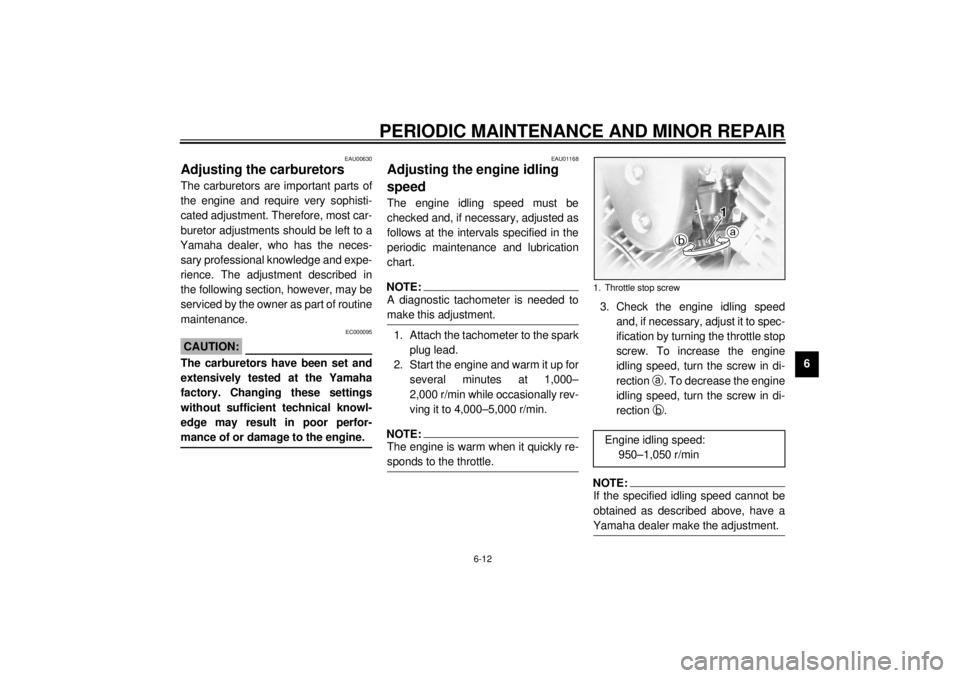
PERIODIC MAINTENANCE AND MINOR REPAIR
6-12
6
EAU00630
Adjusting the carburetors The carburetors are important parts of
the engine and require very sophisti-
cated adjustment. Therefore, most car-
buretor adjustments should be left to a
Yamaha dealer, who has the neces-
sary professional knowledge and expe-
rience. The adjustment described in
the following section, however, may be
serviced by the owner as part of routine
maintenance.
EC000095
CAUTION:@ The carburetors have been set and
extensively tested at the Yamaha
factory. Changing these settings
without sufficient technical knowl-
edge may result in poor perfor-
mance of or damage to the engine. @
EAU01168
Adjusting the engine idling
speed The engine idling speed must be
checked and, if necessary, adjusted as
follows at the intervals specified in the
periodic maintenance and lubrication
chart.NOTE:@ A diagnostic tachometer is needed to
make this adjustment. @1. Attach the tachometer to the spark
plug lead.
2. Start the engine and warm it up for
several minutes at 1,000–
2,000 r/min while occasionally rev-
ving it to 4,000–5,000 r/min.NOTE:@ The engine is warm when it quickly re-
sponds to the throttle. @
3. Check the engine idling speed
and, if necessary, adjust it to spec-
ification by turning the throttle stop
screw. To increase the engine
idling speed, turn the screw in di-
rection
a. To decrease the engine
idling speed, turn the screw in di-
rection
b.NOTE:@ If the specified idling speed cannot be
obtained as described above, have a
Yamaha dealer make the adjustment. @1. Throttle stop screwEngine idling speed:
950–1,050 r/min
E_5KS.book Page 12 Monday, August 21, 2000 10:48 AM
Page 62 of 104
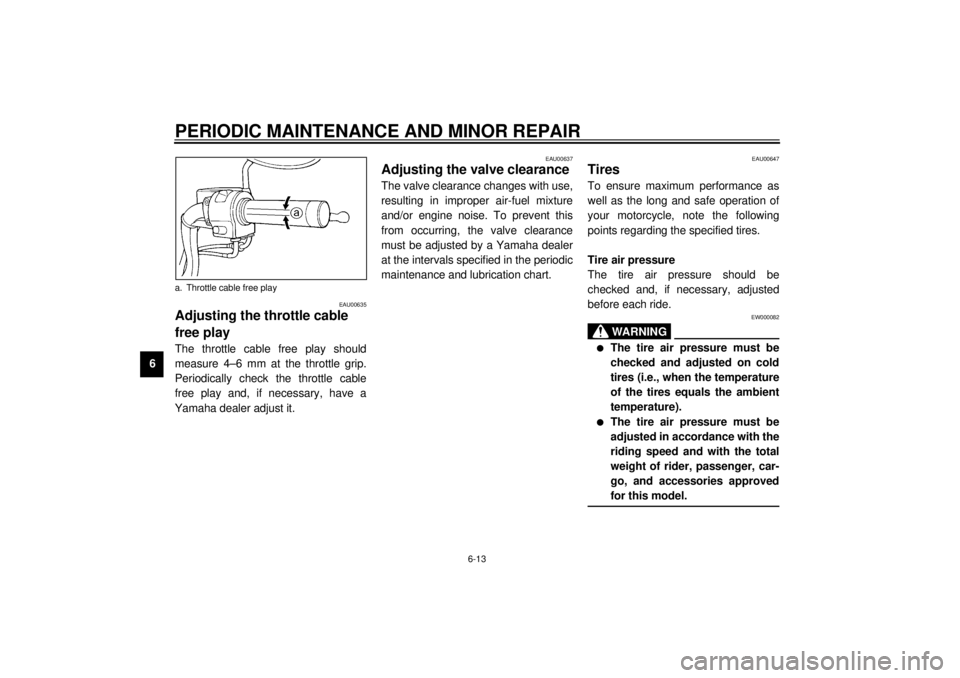
PERIODIC MAINTENANCE AND MINOR REPAIR
6-13
6
EAU00635
Adjusting the throttle cable
free play The throttle cable free play should
measure 4–6 mm at the throttle grip.
Periodically check the throttle cable
free play and, if necessary, have a
Yamaha dealer adjust it.
EAU00637
Adjusting the valve clearance The valve clearance changes with use,
resulting in improper air-fuel mixture
and/or engine noise. To prevent this
from occurring, the valve clearance
must be adjusted by a Yamaha dealer
at the intervals specified in the periodic
maintenance and lubrication chart.
EAU00647
Tires To ensure maximum performance as
well as the long and safe operation of
your motorcycle, note the following
points regarding the specified tires.
Tire air pressure
The tire air pressure should be
checked and, if necessary, adjusted
before each ride.
EW000082
WARNING
@ l
The tire air pressure must be
checked and adjusted on cold
tires (i.e., when the temperature
of the tires equals the ambient
temperature).
l
The tire air pressure must be
adjusted in accordance with the
riding speed and with the total
weight of rider, passenger, car-
go, and accessories approved
for this model.
@
a. Throttle cable free playE_5KS.book Page 13 Monday, August 21, 2000 10:48 AM
Page 71 of 104
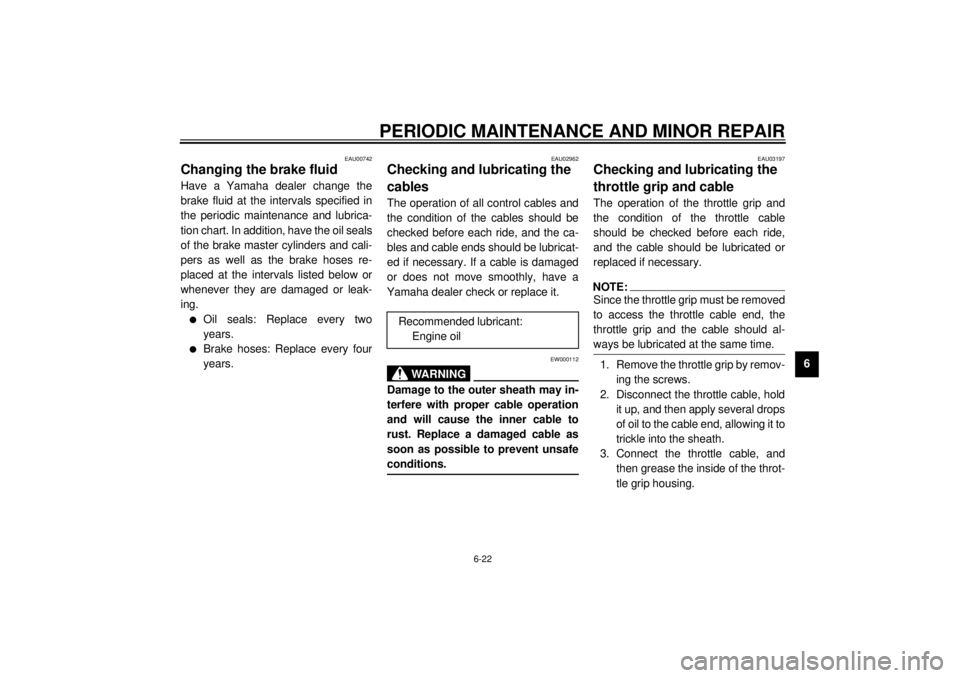
PERIODIC MAINTENANCE AND MINOR REPAIR
6-22
6
EAU00742
Changing the brake fluid Have a Yamaha dealer change the
brake fluid at the intervals specified in
the periodic maintenance and lubrica-
tion chart. In addition, have the oil seals
of the brake master cylinders and cali-
pers as well as the brake hoses re-
placed at the intervals listed below or
whenever they are damaged or leak-
ing.l
Oil seals: Replace every two
years.
l
Brake hoses: Replace every four
years.
EAU02962
Checking and lubricating the
cables The operation of all control cables and
the condition of the cables should be
checked before each ride, and the ca-
bles and cable ends should be lubricat-
ed if necessary. If a cable is damaged
or does not move smoothly, have a
Yamaha dealer check or replace it.
EW000112
WARNING
@ Damage to the outer sheath may in-
terfere with proper cable operation
and will cause the inner cable to
rust. Replace a damaged cable as
soon as possible to prevent unsafe
conditions. @
EAU03197
Checking and lubricating the
throttle grip and cable The operation of the throttle grip and
the condition of the throttle cable
should be checked before each ride,
and the cable should be lubricated or
replaced if necessary.NOTE:@ Since the throttle grip must be removed
to access the throttle cable end, the
throttle grip and the cable should al-
ways be lubricated at the same time. @1. Remove the throttle grip by remov-
ing the screws.
2. Disconnect the throttle cable, hold
it up, and then apply several drops
of oil to the cable end, allowing it to
trickle into the sheath.
3. Connect the throttle cable, and
then grease the inside of the throt-
tle grip housing. Recommended lubricant:
Engine oil
E_5KS.book Page 22 Monday, August 21, 2000 10:48 AM
Page 72 of 104

PERIODIC MAINTENANCE AND MINOR REPAIR
6-23
64. Grease the metal-to-metal contact
surface of the throttle grip, and
then install the grip by installing
the screws.
EAU03199
Checking and lubricating the
brake and shift pedals The operation of the brake and shift
pedals should be checked before each
ride, and the pedal pivots should be lu-
bricated if necessary.
EAU03164
Checking and lubricating the
brake and clutch levers The operation of the brake and clutch
levers should be checked before each
ride, and the lever pivots should be lu-
bricated if necessary. Recommended lubricant:
Throttle cable:
Engine oil
Throttle grip housing and grip:
Lithium-soap-based grease
(all-purpose grease)
Recommended lubricant:
Lithium-soap-based grease
(all-purpose grease)
Recommended lubricant:
Lithium-soap-based grease
(all-purpose grease)
E_5KS.book Page 23 Monday, August 21, 2000 10:48 AM
Page 74 of 104
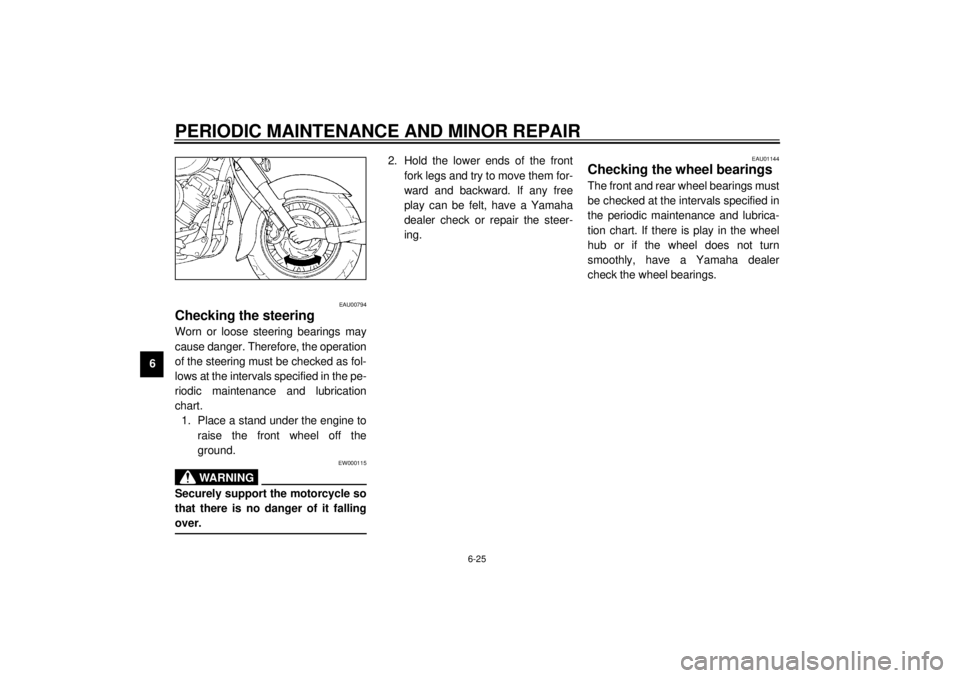
PERIODIC MAINTENANCE AND MINOR REPAIR
6-25
6
EAU00794
Checking the steering Worn or loose steering bearings may
cause danger. Therefore, the operation
of the steering must be checked as fol-
lows at the intervals specified in the pe-
riodic maintenance and lubrication
chart.
1. Place a stand under the engine to
raise the front wheel off the
ground.
EW000115
WARNING
@ Securely support the motorcycle so
that there is no danger of it falling
over. @
2. Hold the lower ends of the front
fork legs and try to move them for-
ward and backward. If any free
play can be felt, have a Yamaha
dealer check or repair the steer-
ing.
EAU01144
Checking the wheel bearings The front and rear wheel bearings must
be checked at the intervals specified in
the periodic maintenance and lubrica-
tion chart. If there is play in the wheel
hub or if the wheel does not turn
smoothly, have a Yamaha dealer
check the wheel bearings.
E_5KS.book Page 25 Monday, August 21, 2000 10:48 AM